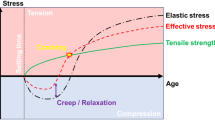Abstract
In order to accurately predict the stress of concrete structures that undergo variations of temperature and moisture, a compliance function is required that considers the fast development of material properties in early-age concrete. The purpose of present study is to identify the viscoelastic behavior in actual concrete structures at early ages. To this end, a numerical method to identify the viscoelastic properties from measured strain and stress histories was investigated and a series of full-scale test members was fabricated, from which the behavior of early-age concrete was directly measured. The relaxation function was identified from measured data in the full-scale members and the existing compliance model, which is based on the solidification theory, was modified for incorporation into the early-age behavior. The modified compliance model described the highly viscoelastic behavior of concrete at very early ages and thus allowed more accurate evaluation of deformation and stress in early-age concrete.















Similar content being viewed by others
References
Bažant ZP (ed) (1988) Mathematical modeling of creep and shrinkage of concrete. John Wiley and Sons, Chichester, New York
Emborg M, Bernander S (1994) Assessment of risk of thermal cracking in hardening concrete. J Eng Mech (ASCE) 123(10):2893–2912
Springenschmid R (ed) (1998) Prevention of thermal cracking in concrete at early ages, state of the art report by RILEM TC 119. E&FN Spon, New York
ACI Committee 209 (1992) Prediction of creep, shrinkage and temperature effect in concrete structures (ACI 209R-92). American Concrete Institute, Detroit, 47 pp
CEB-FIP Model Code (1993) Design code. Thomas Telford, London
Cha SW (1999) Modeling of hydration process and analysis of thermal and hygral stresses in hardening concrete. Seoul National University, Seoul, Korea
de Schutter G (1999) Degree of hydration based Kelvin model for the basic creep of early age concrete. Mater Struct 32(4):260–265
Guěnot I, Torrenti J-M, Laplante P (1996) Stress in early-age concrete: comparison of different creep models. ACI Mater J 93(3):254–259
Habel K, Charron J-P, Denarié E, Brühwiler E (2006) Autogenous deformations and viscoelasticity of UHPFRC in structures. Part I: experimental results. Mag Concr Res 58(3):135–145
Habel K, Charron J-P, Denarié E, Brühwiler E (2006) Autogenous deformations and viscoelasticity of UHPFRC in structures. Part II: numerical modeling. Mag Concr Res 58(3):147–156
Persson B (1999) Influence of maturity on creep of high performance concrete with sealed curing. Mater Struct 32(7):506–519
Westman G (1995) Basic creep and relaxation of young concrete. In: Springenschmid R (ed) Thermal cracking in concrete at early ages. Proceedings of the international symposium by RILEM, TU, Munich, E&FN Spon, London, pp 87–94
Altoubat SA, Lange DA (2001) Tensile basic creep: measurement and behavior at early age. ACI Mater J 98(8):386–393
Cusson D, Hoogeveen T (2008) Internal curing of high-performance concrete with pre-soaked fine lightweight aggregate for prevention of autogenous shrinkage cracking. Cem Concr Res 38(6):757–765
Kamen A, Denarié E, Sadouki H, Brühwiler E (2008) Thermo-mechanical response of UHPFRC at early age—experimental study and numerical simulation. Cem Concr Res 38(6):822–831
Kovler K (1994) Testing system for determining the mechanical behavior of early age concrete under restrained and free uniaxial shrinkage. Mater Struct 27(170):324–330
Østergaard L, Lange DA, Altoubat SA, Stang H (2001) Tensile basic creep of early-age under constant load. Cem Concr Res 31(12):1895–1899
Bažant ZP (1995) Creep and shrinkage prediction model for analysis and design of concrete structures—model B3. Mater Struct 28(180):357–365
Bažant ZP, Prasannan S (1989) Solidification theory for concrete creep: II. verification and application. J Eng Mech (ASCE) 115(8):1704–1725
Bažant ZP (1972) Numerical determination of long-range stress history from strain history. Mater Struct 5(27):135–141
Chapra SC, Canale RP (1990) Numerical methods for engineers. McGraw-Hill, Boston
Oh BH, Cha SW (2003) Nonlinear analysis of temperature and moisture distributions in early-age concrete structures based on degree of hydration. ACI Mater J 100(5):361–370
ACI Committee 207 (1995) Effect of restraint, volume change, and reinforcement on cracking of mass concrete (ACI 207.2R-95). American Concrete Institute, Detroit, 26 pp
Cha SW, Oh BH, Lee HJ (2002) Evaluation of thermal and shrinkage stresses in hardening concrete considering early-age creep effect. J Korea Concr Inst 14(3):382–391
Kawaguchi T, Nakane S (1996) Investigation on determining thermal stress in massive concrete structures. ACI Mater J 93(1):96–101
Bernard O, Brühwiler E (2002) Influence of autogenous shrinkage on early age behaviour of structural elements consisting of concrete of different ages. Mater Struct 35(9):550–556
Neville AM, Dilger WH, Brooks JJ (1983) Creep of plain and structural concrete. Construction Press, London
Byfors J (1980) Plain concrete at early ages. CBI Report FO 38, Sweden
Bažant ZP, Wu ST (1974) Rate-type creep law for aging concrete based on maxwell-chain. Mater Struct 7(37):45–60
Bažant ZP, Baweja S (1995) Justification and refinements of model B3 for concrete creep and shrinkage 2. updating and theoretical basis. Mater Struct 28(182):488–495
Bažant ZP, Křístek V, Vítek JL (1990) Drying and cracking effects in box-girder bridge segment. J Struct Eng (ASCE) 118(1):305–321
Author information
Authors and Affiliations
Corresponding author
Rights and permissions
About this article
Cite this article
Choi, S., Cha, S.W. & Oh, B.H. Identification of viscoelastic behavior for early-age concrete based on measured strain and stress histories. Mater Struct 43, 1161–1175 (2010). https://doi.org/10.1617/s11527-009-9574-z
Received:
Accepted:
Published:
Issue Date:
DOI: https://doi.org/10.1617/s11527-009-9574-z




